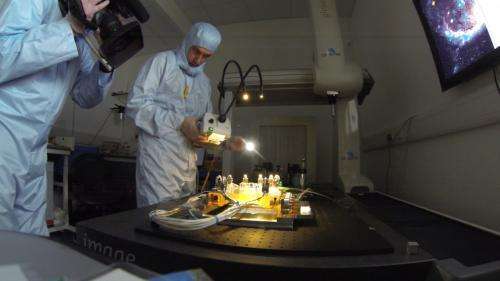Ready for launch: Heart of space mission, LISA Pathfinder, successfully tested

The optical bench of the LISA Pathfinder (LPF) mission passed with flying colors extensive testing at the Institute for Gravitational Research (IGR) at the University of Glasgow.
IGR scientists assured that the high-precision measurement system is ready to survive tremendous forces up to 35 g (35 times the gravitational acceleration on Earth) during rocket launch. "With the successful tests we reached an important milestone. The sophisticated laser interferometer works very well and is ready for its job in space. We are really excited that the LPF mission is well underway for the launch date of 2015," said Dr. Christian Killow (Scottish Universities Physics Alliance Advanced Fellow).
"LISA Pathfinder is an absolutely unique mission, and the spacecraft is a masterpiece. Once it has been launched, we can't get it back to improve or repair something. So, we have to be absolutely certain all of its components can withstand the stresses during launch and in flight and that they will all work together flawlessly," explains Prof. Dr. Karsten Danzmann, Director at the Max Planck Institute for Gravitational Physics and of the Institute for Gravitational Physics at the Leibniz Universität Hannover.
LISA Pathfinder is an ESA technology test mission that aims to prove essential key technologies for future space-based gravitational-wave observatories, which cannot be tested on Earth, but only in space. For this purpose, one laser arm of a planned large gravitational wave mission is reduced from millions of kilometers to 40 cm to fit into a single spacecraft. The optical bench tested at the IGR in Glasgow is the heart of LPF. It is now on its way to Astrium Germany for further integration into the LISA Pathfinder Technology Package. At Astrium the optical bench has to undergo health checks of the photodiodes that turn the laser beams into electrical signals, and also micron-level measurement of the beam positions on the photodiodes—a very strong indicator that the bench has survived transit unchanged.
Paving the way
LISA Pathfinder is paving the way for a large-scale space mission designed to detect one of the most elusive phenomena in astronomy—gravitational waves. Extreme precision is required to detect the tiny ripples in the fabric of space and time predicted by Albert Einstein. A direct detection of gravitational waves will add a new sense to our perception of the universe: for the first time we will be able to LISTEN to the universe because gravitational waves are similar to sound waves. Hence gravitational wave astronomy will complement our understanding of the universe and its evolution. Gravitational waves measured by a large mission in space will allow us to e.g. trace the formation, growth, and merger history of massive black holes. Also it will enable us to confront General Relativity with observations, and it will probe new physics and cosmology with gravitational waves.
International collaboration
LPF is an ESA led mission. It involves European space companies and research institutes from France, Germany, Italy, The Netherlands, Spain, Switzerland and UK and the US space agency NASA.
The concept and details of the optical system for LISA Pathfinder have been developed at the Max Planck Institute for Gravitational Physics (Albert Einstein Institute) in Hanover , Germany. Its director Karsten Danzmann is Co-Principal Investigator of the mission and shares the scientific leadership with Stefano Vitale, University of Trento, Italy.
The Institute for Gravitational Research (IGR) from University of Glasgow played a major role in defining the interferometer elements and the breadboard model of LISA Pathfinder. For building the flight interferometer IGR scientists developed precision alignments at a sub-micron level used to mount components onto the optical bench. IGR scientists also designed and manufactured a highly stable fiber collimator, which aligns the laser beams.
The future
ESA has recently published a call for White Papers describing science themes for the next large ESA missions L2 and L3 to be launched in 2028 and 2034. On 24 May 2013 the eLISA Consortium submitted a White Paper to ESA describing the science case for the eLISA mission: The Gravitational Universe.
The eLISA consortium, a self-funded and independent collaboration of scientists from Denmark, France, Germany, Italy, Netherlands, Spain, Switzerland and the UK is convinced that a spaceborne low-frequency gravitational wave observatory to be launched in 2028 is the ideal tool to make progress in our understanding of the universe.
Provided by European Space Agency




















